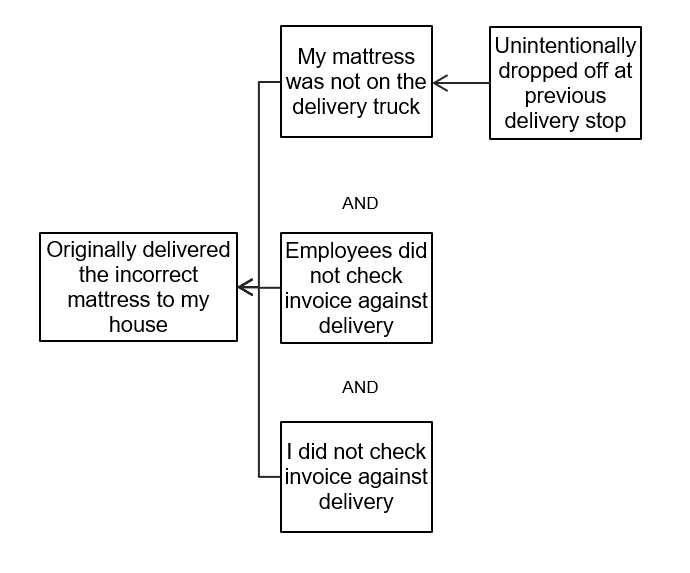When you work for ThinkReliability you get in the habit of looking at incidents in every-day-life and building a mental Cause Map. One common mistake often made is stopping short in an incident, sometimes resulting in blame. The below example is a real-life example that highlights the concept of blame versus accountability.
Last year I bought a new mattress (a 17” thick slice of heaven). When it came time for the furniture company to deliver the mattress, I got the typical four-hour window that required me to be home (knowing that it would likely be 5 minutes at the end of the window). I was in a position that required me to take vacation to be able to leave work. This was annoying, but I had the optimism of going to bed on my new beauty.
To my surprise, the delivery truck was at my house within a minute of my arrival. The two nice gentlemen unloaded the new mattress and took away the old. I signed the invoice and away they went.
At this point I was excited knowing that I could get back to work in less than an hour. I went to the bedroom to make the bed only to discover they dropped off a rock-hard, so-called-mattress.
I ran out of the front door to see if I could catch them but they were out of sight. I did not have the truck driver’s cell phone number so I immediately called the furniture store to explain what happened, hoping to catch the truck immediately. The manager attempted to track down the truck but the deliveries had the truck headed into the mountains (rural Colorado), limiting cell phone service. The manager left a message with the delivery truck and we’d have to wait until they got back into cell service to correct the issue.
During this time, I beat myself up over the incident because I knew better. Was I annoyed at the delivery guys? Yes, but I was even more annoyed at myself. Not only did they drop off the wrong mattress, but I signed for it.
Someone cutting their investigation short may stop here:

Someone with a blame mentality may just focus on one area:  But if you have been in a ThinkReliability Cause Mapping, root cause investigation training, then you are aware of the fast food example. You know the one, where you’re craving some salty, delicious French fries so you go through the drive-through, order your #1 and salivate the entire ride home. Once you get home, prepare your sauces on a plate, your napkin, you begin to empty the bag. Chicken sandwich, check. Straw for the soda, check. Ketchup, check. Hands begin to frantically search the seemingly endless bottom of the bag. No fries. THEY FORGOT THE FRIES! But who’s fault is it? ...or does it really matter since you are the one sitting at home with the wrong order? I should have verified that the tasty morsels were in the bag before driving off.
But if you have been in a ThinkReliability Cause Mapping, root cause investigation training, then you are aware of the fast food example. You know the one, where you’re craving some salty, delicious French fries so you go through the drive-through, order your #1 and salivate the entire ride home. Once you get home, prepare your sauces on a plate, your napkin, you begin to empty the bag. Chicken sandwich, check. Straw for the soda, check. Ketchup, check. Hands begin to frantically search the seemingly endless bottom of the bag. No fries. THEY FORGOT THE FRIES! But who’s fault is it? ...or does it really matter since you are the one sitting at home with the wrong order? I should have verified that the tasty morsels were in the bag before driving off.
A complete investigation will try to understand all the checks and/or verifications that could have identified the potential issue.

I knew I should have checked the item number or at least taken one decent look at what was dropped off at my house. Over an hour passed when I saw the truck pull back into my driveway. At this point we discovered that my mattress was not on the truck, they had dropped it off at someone else’s house during an earlier stop on their delivery route. They now had to retrace their delivery stops to sort out the confusion, extending the delivery window to 6 hours.
When they came back for the second time the delivery guys were very apologetic. I informed them that it was also my fault for not checking the items before they left. After all, I did sign the invoice. I asked them to please have the customer double check the inventory of the delivery with them so that they share in responsibility and accountability. I assured them that if they do this every time it will improve customer service (and shorten their work day!).
Moral of the story… there’s always more than one cause to an incident. By digging into the details of an incident, multiple sources of accountability and responsibility will be revealed.
Be accountable. Take responsibility. Be proactive. Use checklists every time. Make a routine and stick with it every time. Use your mistakes as learning opportunities and improve your work processes. Ask “why did that happen” and “how can I prevent it from happening again.” Those two simple questions are at the heart of Cause Mapping.











